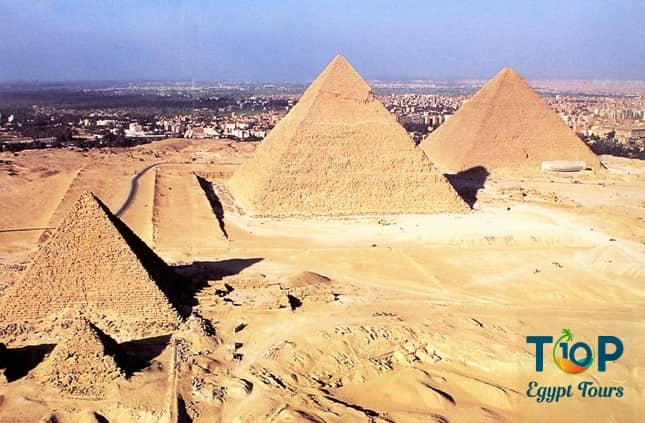Giza stands as a testament to Egypt’s rich history and cultural legacy. Home to the iconic pyramids and the Sphinx, this ancient marvel has captivated the world for centuries.
1. The Pyramids of Giza: Architectural Marvels:
1.1 The Great Pyramid of Khufu:
Giza’s skyline is dominated by the Great Pyramid of Khufu, one of the Seven Wonders of the Ancient World. Built during the Fourth Dynasty of the Old Kingdom,Standing at a staggering height of approximately 146 meters (481 feet), it held the title of the tallest man-made structure for over 3,800 years.
1.2 Pyramid of Khafre:
The Pyramid of Khafre commands attention with its imposing stature and intricate details. Built during the same era as the Great Pyramid, around 2558–2532 BCE, the Pyramid of Khafre stands as a testament to the architectural prowess of ancient Egypt, serving as the final resting place for Pharaoh Khafre, the son of Khufu.
1.3 Pyramid of Menkaure:
Completing the trio of Giza’s pyramids, the Pyramid of Menkaure stands as a testament to the enduring grandeur of the Pharaonic era. Built during the Fourth Dynasty, around 2510–2490 BCE, this pyramid is the smallest of the three main pyramids in Giza but holds its own significance in the archaeological landscape.
The Pyramid of Menkaure reaches a height of approximately 65 meters (213 feet), making it significantly smaller than its neighboring pyramids.
2. The Sphinx: Guardian of Giza’s Mysteries
Dominating the Giza plateau with its enigmatic presence, the Sphinx stands as an iconic symbol of ancient Egypt’s mystical allure. Carved from a single limestone outcrop, this colossal creature, with the body of a lion and the face of a pharaoh, adds an extra layer of fascination to the Giza complex.
Over the millennia, the Sphinx has faced the ravages of time and natural elements. Historical records indicate that various pharaohs, including Thutmose IV, initiated restoration efforts to clear the surrounding sand and preserve this iconic monument.
The Sphinx has inspired numerous myths and legends throughout history. The most famous is the tale of the “Dream Stele,” where Thutmose IV recounts a dream in which the Sphinx promises him the throne if he clears the sand covering its body. These tales contribute to the Sphinx’s mystique, inviting speculation about its role in ancient Egyptian society.
3. Solar Boat Museum
Is located on the Giza Plateau near the Great Pyramid of Khufu (Cheops) in Egypt. It houses one of the most significant archaeological discoveries related to ancient Egyptian funerary beliefs – a well-preserved ancient boat known as the Khufu Ship or Solar Boat.
The Solar Boat is considered to have great importance in the context of ancient Egyptian funerary beliefs and religious practices. It is commonly believed to have played a role in the afterlife journey of the pharaoh, particularly in connection with the solar deity Ra.
In ancient Egyptian mythology, the sun god Ra traveled through the sky during the day and through the underworld at night. The Solar Boat was thought to be a vessel that would transport the pharaoh’s soul, in the form of Ra, across the celestial waters in the afterlife. This symbolic journey represented the cyclical nature of life, death, and rebirth.
The Giza Plateau is home to not only the Great Pyramid of Khufu and the Solar Boat Museum but also several other significant archaeological sites that provide valuable insights into ancient Egyptian history and culture. Two particularly noteworthy sites near Giza are the ancient city of Memphis and the necropolis of Saqqara.
Memphis:
Location: Memphis was the capital of ancient Egypt and is located south of the Giza Plateau, near the modern city of Cairo.
Significance: Memphis served as the political and cultural center of Egypt for much of its early history. It was the seat of power for pharaohs and home to numerous temples, palaces, and administrative buildings. One of its most famous landmarks is the colossal statue of Ramses II, also known as the “Memphis Sphinx,” which is now displayed in the open-air museum near the modern town of Mit Rahina. The ruins of Memphis offer a glimpse into the grandeur of ancient Egyptian civilization.
Saqqara:
Location: Saqqara is an extensive necropolis located south of Giza and is easily accessible from Cairo.
Significance: Saqqara is renowned for its vast burial grounds and the iconic Step Pyramid of Djoser, credited to the architect Imhotep. The Step Pyramid is considered the earliest large-scale cut-stone construction in Egypt and represents a significant architectural milestone. Saqqara features numerous mastabas (flat-roofed tombs) and pyramids, offering a comprehensive view of the evolution of burial practices and architectural styles over different periods of ancient Egyptian history. The site also includes the Serapeum, a complex of underground galleries that once housed the burials of sacred Apis bulls.
In conclusion, the Giza Plateau stands as a testament to the grandeur, ingenuity, and spiritual depth of ancient Egyptian civilization. Dominated by the iconic pyramids, including the Great Pyramid of Khufu, Giza represents the pinnacle of monumental architecture and engineering prowess. The Solar Boat Museum, housing the well-preserved Khufu Ship, further enriches our understanding of ancient Egyptian funerary beliefs, emphasizing the symbolic importance of the afterlife journey.



Comment (0)